Text

The total solar eclipse seen in Dallas, Texas on Monday, April 8, 2024!! A total solar eclipse swept across a narrow portion of the North American continent from Mexico’s Pacific coast to the Atlantic coast of Newfoundland, Canada. A partial solar eclipse was visible across the entire North American continent along with parts of Central America and Europe.
Was anyone able to see it?
Image Credit & Copyright: NASA/Keegan Barber
#astronomy#space#science#universe#total solar eclipse#solar eclipse#eclipse#solar#sun#moon#Canada#Mexico#USA#partial eclipse#solar eclipse 2024#follow#like#reblog#the first star#the first starr#thefirststar#thefirststarr#nasa#apod#tumblr#blog
113 notes
·
View notes
Text
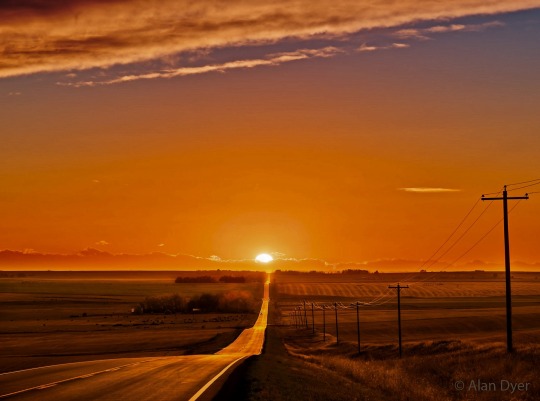
What's that at the end of the road? The Sun. Many towns have roads that run east-west, and on two days each year, the Sun rises and sets right down the middle. Yesterday, in some parts of the world (today in others), is one of those days: an equinox. Not only is this a day of equal night and day time, but also a day when the sun rises precisely to the east and sets due west. Displayed here is a picturesque rural road in Alberta, Canada that runs approximately east-west. The featured image was taken during the September Equinox of 2021, but the geometry remains the same every year. In many cultures, this March equinox is taken to be the first day of a season, typically spring in Earth's northern hemisphere, and autumn in the south.
Image Credit & Copyright: Alan Dyer, Amazingsky.com, TWAN
#astronomy#space#science#universe#equinox#vernal equinox#spring#first day of spring#spring equinox#sun#east#west#sun set#Sun rise#sunset#sunrise#follow#like#reblog#the first star#the first starr#thefirststar#thefirststarr#nasa#apod#hemisphere#seasons#autumn#autum equinox#autumnal equinox
85 notes
·
View notes
Text

There's some science to February's bonus day!!
Every four years, during a leap year, the imperfect match between the length of a calendar year and Earth's orbit result in a calendar adjustment known as a leap day.
The length of a year is based on how long it takes a planet to revolve around the Sun. Earth takes about 365.2422 days to make one revolution around the Sun. That's about six hours longer than the 365 days that we typically include in a calendar year. As a result, every four years we have about 24 extra hours that we add to the calendar at the end of February in the form of leap day.
Without leap day, the dates of annual events, such as equinoxes and solstices, would slowly shift to later in the year, changing the dates of each season. After only a century without leap day, summer wouldn't start until mid-July!
Image Credit & Copyright: NASA/TERRA-MODIS
#astronomy#space#science#universe#leap day#leap year#february#February 29#earth#planet#sun#revolution#revolve#year#calendar#cloud#land#water#follow#like#reblog#the first star#the first starr#thefirststar#thefirststarr#nasa#apod#tumblr#blog#space blog
96 notes
·
View notes
Text
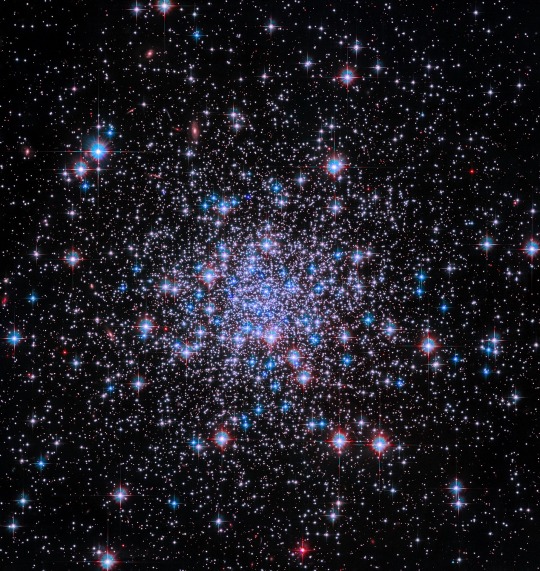
This new NASA Hubble Space Telescope view shows the globular cluster NGC 2298, a sparkling collection of thousands of stars held together by their mutual gravitational attraction. Globular clusters are typically home to populations of older stars, and they mostly reside in the dusty outskirts of galaxies. Scientists utilized the telescope’s unique ability to observe the cosmos across multiple wavelengths of light to study NGC 2298 in ultraviolet, visible, and near-infrared light. This valuable information helps astronomers better understand how globular clusters behave, including their internal movements, orbits, and the evolution of their stars.
Image Credit & Copyright: NASA, ESA, G. Piotto (Universita degli Studi di Padova), and A. Sarajedini (Florida Atlantic University);
#astronomy#space#science#universe#globular cluster#star cluster#cluster#globular#star#Hubble#hubble space telescope#telescope#blue stars#old stars#study#follow#like#reblog#the first star#the first starr#thefirststar#thefirststarr#nasa#apod#tumblr#blog#space blog#hst#galaxy#gravity
157 notes
·
View notes
Text

It’s oh-so-easy to be mesmerized by this spiral galaxy known as NGC 4254. Follow its clearly defined arms, which are brimming with stars, to its center, where there may be old star clusters and, sometimes, active supermassive black holes. NASA’s James Webb Space Telescope delivered highly detailed scenes of this spiral galaxy in a combination of near- and mid-infrared light.
Image Credit & Copyright: NASA, ESA, CSA, STScI, Janice Lee (STScI), Thomas Williams (Oxford), and the PHANGS team
#astronomy#space#science#universe#galaxy#spiral galaxy#spiral#stars#hot stars#young stars#supermassive black hole#black hole#supermassive#James Webb#james webb space telescope#jwst#star clusters#star#cluster#star cluster#follow#like#reblog#the first star#the first starr#thefirststar#thefirststarr#nasa#apod#tumblr
149 notes
·
View notes
Text

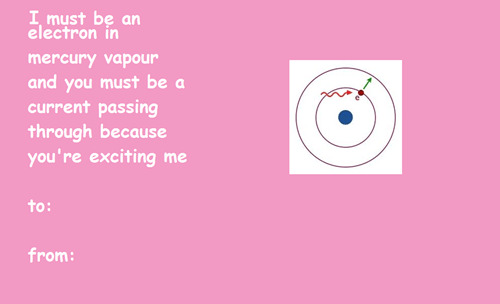



HAPPY VALENTINE’S DAY!!!
Some cards to help make your day extra special!!!!
🩷❤️🧡💛💚🩵💙💜🤍🩶🤎💕🖤❣️💓💗💝💘💖
love you all!!! xoxoxoxo
#astronomy#space#science#universe#valentine#Valentine’s Day#Valentine’s Day cards#valentines#day#cards#memes#Valentine’s Day memes#valentine memes#will you be my valentine#be mine#follow#like#reblog#the first star#the first starr#thefirststar#thefirststarr#nasa#apod#tumblr#st valentine#funny#tumblr valentine#xoxo
81 notes
·
View notes
Text
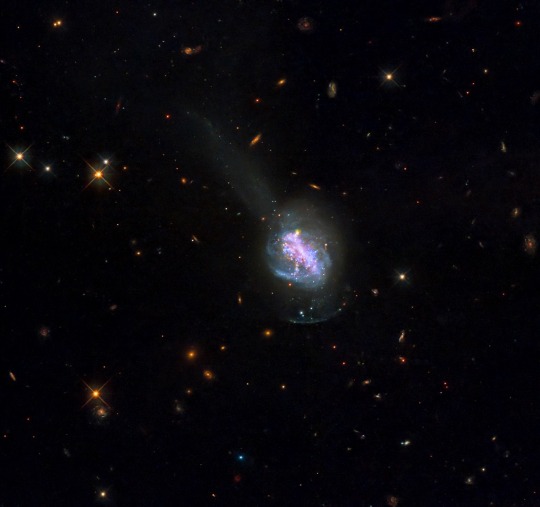
This new NASA Hubble Space Telescope image shows ESO 185-IG013, a luminous blue compact galaxy (BCG). BCGs are nearby galaxies that show an intense burst of star formation. They are unusually blue in visible light, which sets them apart from other high-starburst galaxies that emit more infrared light.
Image Credit & Copyright: NASA, ESA, and R. Chandar (University of Toledo); Processing: Gladys Kober (NASA/Catholic University of America)
#astronomy#space#science#universe#galaxy#blue compact galaxy#compact galaxy#blue compact#Hubble#hubble space telescope#high starburst#starburst#starburst galaxy#blue light#follow#like#reblog#the first star#the first starr#thefirststar#thefirststarr#nasa#apod#tumblr#blog#space blogger#space blog
151 notes
·
View notes
Text

The northern lights shine in this night skyview from Earth's stratosphere, captured on January 15. The single, 5 second exposure was made with a hand-held camera on board an aircraft above Winnipeg, Canada. During the exposure, the lights below leave colorful trails. Above the horizon, energetic particles accelerated along Earth's magnetic field at the planet's polar regions excite oxygen atoms to create the shimmering display of Aurora Borealis. The aurora's characteristic greenish hue is generated at altitudes of 100-300 kilometers and red at even higher altitudes and lower atmospheric densities. The glow of faint stars along our Milky Way galaxy arcs through the night, while the Andromeda galaxy extends this northern skyview to extragalactic space. A hint of Andromeda, the closest large spiral to the Milky Way, can just be seen to the upper left.
Image Credit & Copyright: Ralf Rohner
#astronomy#space#science#universe#earth#Winnipeg#Canada#northern lights#aurora borealis#plane#window#exposure#oxygen#atoms#excite#follow#like#reblog#the first star#the first starr#thefirststar#thefirststarr#nasa#apod#tumblr#blog#space blog
59 notes
·
View notes
Text

To some it looks like a cat's eye. To others, like a giant cosmic conch shell. This is actually one of the brightest and most highly detailed planetary nebula known- the Cats Eye Nebula. It is composed of gas expelled in the brief yet glorious phase near the end of life of a Sun-like star. This nebula's dying central star may have produced the outer circular concentric shells by shrugging off outer layers in a series of regular convulsions. The formation of the beautiful inner structures, however, is not well understood. The featured image is a composite of a digitally sharpened Hubble Space Telescope image with X-ray light captured by the orbiting Chandra Observatory. The exquisite nebula spans over half a light-year across. Of course, by gazing into this Cat's Eye, humanity may well be seeing the fate of our sun, destined to enter its own planetary nebula phase of evolution ... in about 5 billion years.
Image Credit & Copyright: NASA Hubble, Chandra
Processing Copyright: Rudy Pohl
#astronomy#space#science#universe#nebula#cats eye#cats eye nebula#Hubble#X-ray#Chandra telescope#bright#light year#planetary nebula#sun#explode#supernova#follow#like#reblog#the first star#the first starr#thefirststar#thefirststarr#nasa#apod#tumblr#blog#space blog
170 notes
·
View notes
Text
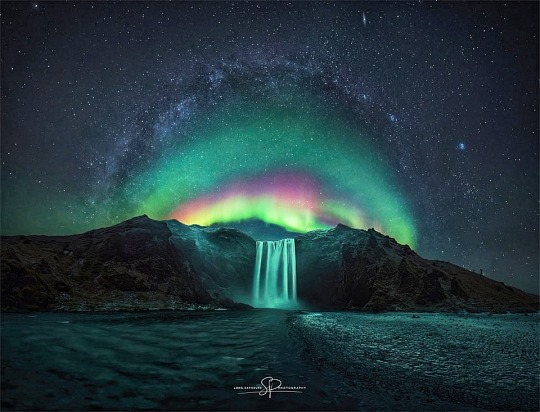
Yes!! Auroras can look like rainbows even though they are completely different phenomena. Auroras are caused by sun-created particles being funnelled into Earth's atmosphere by its magnetic field. It creates colours by exciting atoms at different heights. Alternately, rainbows are created by sunlight backscattering off falling raindrops, and the different colors are refracted by slightly different angles. The featured picture is composed of several images taken on the same night last month near the Skógafoss waterfall in Iceland. The photographer planned on only capturing the central band of our Milky Way galaxy over the picturesque cascade. But by luck, a spectacular aurora soon appeared just below the curving arch of the Milky Way. Far in the background, the Pleiades star cluster and the Andromeda galaxy can be found.
Image Credit & Copyright: Stefano Pellegrini
#astronomy#space#science#universe#Milky Way#galaxy#aurora#aurora borealis#rainbow#waterfall#stars#constellations#andromeda#charged partials#reflections#sun#sunlight#follow#like#reblog#the first star#the first starr#thefirststar#thefirststarr#nasa#apod#tumblr#blog#space blog#space Tumblr
232 notes
·
View notes
Note
This would be cool for a spacemass day, many people still don't realize Uranus has rings

Gonna share some submissions for #spacemas!!
This is such a cool picture of Uranus- and they’re right! People do often forget that all of the gas giants have rings- even Jupiter!
32 notes
·
View notes
Text

SPACEMAS DAY 25 ✨🪐🌎☄️☀️🌕
MERRY CHRISTMAS!!!! These last 25 days have been so fun! Thank you for coming along with me!!
Majestic on a cosmic scale, M100 is known as a grand design spiral galaxy. It’s a large galaxy of over 100 billion stars with well-defined spiral arms that is similar to the Milky Way Galaxy. Also one of the brightest members of the Virgo Cluster of galaxies, M100 (aka NGC 4321) is 56 million light-years away toward the constellation of Berenice's Hair (Coma Berenices). This Hubble Space Telescope image of M100 was taken with the Wide Field Camera 3 and accentuates bright blue star clusters and intricate winding dust lanes which are hallmarks of this class of galaxies. Studies of variable stars in M100 have played an important role in determining the size and age of the Universe.
Image Credit & Copyright: NASA, ESA, Hubble
#astronomy#space#science#universe#spacemas#day 25#christmas#merry christmas#galaxy#Virgo cluster#Milky Way#spiral#spiral galaxy#follow#like#reblog#the first star#the first starr#thefirststar#thefirststarr#nasa#apod#tumblr#blog#tumblr blog#space blog
92 notes
·
View notes
Text

SPACEMAS DAY 24 ✨🪐🌎☄️☀️🌕
Merry Christmas Eve everyone 🎄🎅🏻☃️❄️🥰
Formed within the nebula cataloged as NGC 281, are the stars of open cluster IC 1590. The cluster's young, massive stars ultimately power the pervasive nebular glow. The eye-catching shapes looming in the featured portrait of NGC 281 are sculpted dusty columns and dense globules seen in silhouette, eroded by intense, energetic winds and radiation from the hot cluster stars. If they survive long enough, the dusty structures could also be sites of future star formation. Called the Pacman Nebula because of its overall shape, NGC 281 is about 10,000 light-years away in the constellation Cassiopeia. This sharp composite image was made through narrow-band filters. It combines emission from the nebula's hydrogen and oxygen atoms to synthesize red, green, and blue colors. The scene spans well over 80 light-years.
Image Credit & Copyright: Craig Stocks
#astronomy#space#science#universe#spacemas#day 24#cassiopeia#nebula#star cluster#light year#stars#nebular glow#Pac-Man#Pac-Man nebula#follow#like#reblog#the first star#the first starr#thefirststar#thefirststarr#nasa#apod#tumblr#blog#space blog#constellation#Christmas Eve#merry Christmas
76 notes
·
View notes
Text
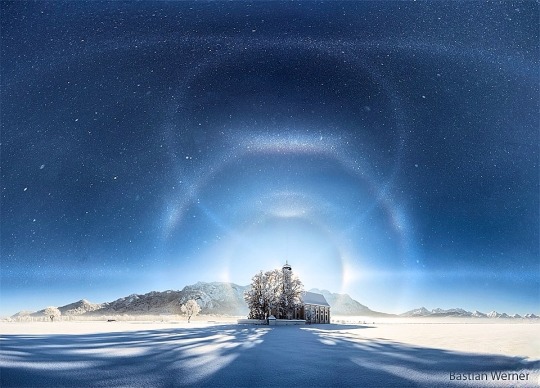
SPACEMAS DAY 23 ✨🪐🌎☄️☀️🌕
Since it’s officially winter now (in this hemisphere at least) I thought this picture for today would be fitting!!
What's causing these unusual sky arcs? Ice crystals! While crossing a field of fresh snow near Füssen, Bavaria, Germany, this photographer noticed that he had entered an ice fog. For suspended water to freeze into an ice fog requires quite cold temperatures, and the air temperature on this day was measured at well below zero. The ice fog was reflecting light from the sun setting behind St. Coleman Church. The result was this spectacular image. First, the spots in the featured picture are not background stars but suspended ice and snow. Next, two prominent ice halos are visible: the 22-degree halo and the 46-degree halo. Multiple arcs are also visible, including, from top to bottom, antisolar (subsun), circumzenithal, Parry, tangent, and parhelic (horizontal). Finally, the balloon shaped curve connecting the top arc to the Sun is the rarest of all: it is the heliac arc, created by reflection from the sides of hexagonally shaped ice crystals suspended in a horizontal orientation.
Image Credit & Copyright: Bastian Werner
#astronomy#space#science#universe#spacemas#day 23#Germany#ice crystals#suspended ice crystals#sky arcs#sun#reflection#beautiful#stars#earth#wow#follow#like#reblog#the first star#the first starr#thefirststar#thefirststarr#nasa#apod#tumblr#blog#space blog#halo#ice halo
48 notes
·
View notes
Text
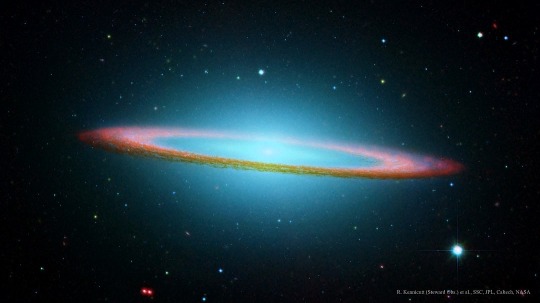
SPACEMAS DAY 22 ✨🪐🌎☄️☀️🌕
This floating ring is a galaxy, or at least part of one. This is the photogenic Sombrero Galaxy, one of the largest galaxies in the nearby Virgo Cluster of Galaxies. Typically, there’s a dark band of dust that obscures the mid-section of the Sombrero Galaxy in optical light. But in infrared light, it actually glows brightly. The featured image, digitally sharpened, shows this infrared glow. It was recorded by the orbiting Spitzer Space Telescope and then superposed in false-color on an existing image taken by NASA's Hubble Space Telescope in visible light. The Sombrero Galaxy, also known as M104, spans about 50,000 light years across and lies 28 million light years away. M104 can be seen with a small telescope in the direction of the constellation Virgo.
Image Credit & Copyright: R. Kennicutt (Steward Obs.) et al., SSC, JPL, Caltech, NASA
#astronomy#space#science#universe#spacemas#day 22#sombrero#galaxy#sombrero galaxy#infrared#infrared light#Virgo#Virgo cluster#constellation#light years#optical light#optic#follow#like#reblog#the first star#the first starr#thefirststar#thefirststarr#nasa#apod#tumblr#blog#space blog#telescope
115 notes
·
View notes
Text

SPACEMAS DAY 21 ✨🪐🌎☄️☀️🌕
This pretty nebula’s shape and color in this view is reminiscent of a robin's egg and lies about 1,500 light years away. The cosmic cloud spans about 3 light-years, and is within the southern constellation Fornax. Classified as a planetary nebula, egg-shaped NGC 1360 doesn't represent a beginning though. Instead it corresponds to a final phase of an aging star. Actually, visible at the center of the nebula, the central star of NGC 1360 is known to be a binary star system likely consisting of two evolved white dwarf stars, less massive but much hotter than the Sun. Their intense and invisible ultraviolet radiation has stripped away electrons from the atoms in their mutually surrounding gases. The predominant blue-green hue of NGC 1360 is the strong emission produced as electrons recombine with doubly ionized oxygen atoms.
Image Credit & Copyright: Dong Liang
#astronomy#space#science#universe#spacemas#day 21#nebula#egg#egg nebula#blue hue#binary star#white dwarf#planetary nebula#light year#south#robins egg#supernova#follow#like#reblog#the first star#the first starr#thefirststar#thefirststarr#nasa#apod#tumblr#blog#space blog#tumblr blog
36 notes
·
View notes
Text
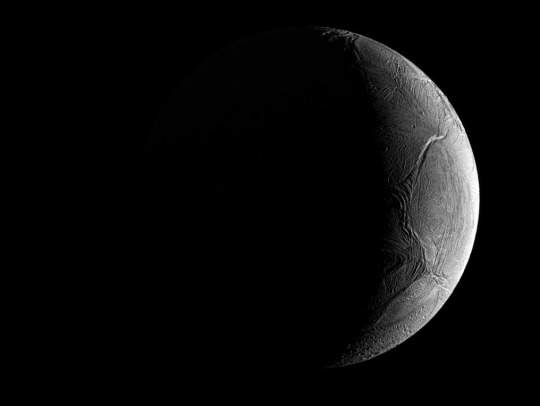
SPACEMAS DAY 20 ✨🪐🌎☄️☀️🌕
‼️ I can’t believe there’s only 5 more days of this!!! Make sure to send me any of your favourite images for a chance to be featured!! ‼️
Peering from the shadows, Saturn’s inner moon Enceladus is front and centre in this image from the Cassini spacecraft. North is up in the scene captured during November 2016 as Cassini's camera was pointed in a nearly sunward direction about 130,000 kilometers from the moon's bright crescent. In fact, the moon reflects over 90 percent of the sunlight it receives, giving its surface about the same reflectivity as fresh snow. Only about 500 kilometers in diameter, Enceladus is a surprisingly active moon. Data and images collected during Cassini's flybys have revealed water vapor and ice grains spewing from south polar geysers and evidence of an ocean of liquid water hidden beneath the moon's icy crust.
Image Credit & Copyright: NASA
#astronomy#space#science#universe#Cassini#moon#Saturn#enceladus#Saturn moon#icy#reflective#surface#sun#sunlight#Cassini space craft#Cassini Saturn#follow#like#reblog#the first star#the first starr#thefirststar#thefirststarr#nasa#apod#tumblr#blog#space blog#spacemas#day 20
26 notes
·
View notes